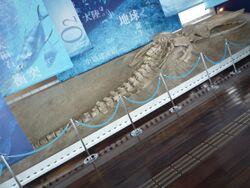Biology:Incakujira
| Incakujira | |
|---|---|

| |
| Holotype specimen exhibited at Gamagori, Japan | |
| Scientific classification | |
| Domain: | Eukaryota |
| Kingdom: | Animalia |
| Phylum: | Chordata |
| Class: | Mammalia |
| Order: | Artiodactyla |
| Infraorder: | Cetacea |
| Superfamily: | Balaenopteroidea |
| Family: | Balaenopteridae |
| Genus: | †Incakujira Marx & Kohno, 2016 |
| Type species | |
| †Incakujira anillodefuego Marx & Kohno, 2016
| |
Incakujira (meaning Inca whale) is a genus of rorqual whales that lived during the Late Miocene epoch in what are now the coasts of Peru, about 8 million to 7.3 million years ago. It contains a single species, Incakujira anillodefuego, named and described in 2016 with known specimens coming from the Pisco Formation.
Description

Incakujira differs from other rorquals (fossil and extant) in having a less attenuated rostrum and the features of the maxilla, supraorbital, and remainder of the cranium. Kujira in the genus name means "whale" in Japanese.[1]
Paleobiology
The twisted postglenoid process of the squamosal suggests that the lunge-feeding capabilities of Incakujira were not as great as those of extant rorquals, and that Incakujira itself also pursued additional krill-feeding strategies like skimming.[1]
References
- ↑ 1.0 1.1 Marx, F. G.; Kohno, N. (2016). "A new Miocene baleen whale from the Peruvian desert". Royal Society Open Science 3 (10): 1–27. doi:10.1098/rsos.160542. PMID 27853573. Bibcode: 2016RSOS....360542M.
External links
Wikidata ☰ Q48966039 entry
 |

